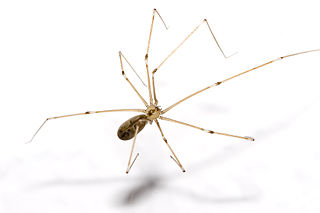
Huntsman spiders, members of the family Sparassidae, are known by this name because of their speed and mode of hunting. They are also called giant crab spiders because of their size and appearance. Larger species sometimes are referred to as wood spiders, because of their preference for woody places. In southern Africa the genus Palystes are known as rain spiders or lizard-eating spiders. Commonly they are confused with baboon spiders from the Mygalomorphae infraorder, which are not closely related.

The Pholcidae are a family of araneomorph spiders. The family contains over 1,800 pholcids, including those commonly known as the marbled cellar spider , daddy long-legs spider, granddaddy long-legs spider, carpenter spider, daddy long-legger, vibrating spider, gyrating spider, long daddy, and skull spider. The family, first described by Carl Ludwig Koch in 1850, is divided into 94 genera.
Poulsenia is a monotypic genus of trees in the family Moraceae. The only species is Poulsenia armata, native to rainforests from Mexico south to Bolivia.

The Chilean angelshark is an angelshark of the family Squatinidae found in the subtropical waters of Chile, that grows up to 1.03 metres in length. The holotype is lost. Reproduction is ovoviviparous.

Banksia armata, commonly known as prickly dryandra, is a species of often sprawling shrub that is endemic to Western Australia. It has deeply serrated leaves with sharply pointed lobes and spikes of about 45 to 70 yellow flowers.

Banksia armata var. armata is a variety of shrub that is endemic to Western Australia. It differs from the other variety in having a lignotuber, narrower leaves with more sides lobes and shorter flowers. It is also usually a shorter plant.

The "Armata" Universal Combat Platform is a Russian advanced next generation modular heavy military tracked vehicle platform. The Armata platform is the basis of the T-14, the T-15, a combat engineering vehicle, an armoured recovery vehicle, a heavy armoured personnel carrier, a tank support combat vehicle and several types of self-propelled artillery, including the 2S35 Koalitsiya-SV under the same codename based on the same chassis. It is also intended to serve as the basis for artillery, air defense, and NBC defense systems. The new "Armata" tank platform is meant to replace the older Russian MBTs and APCs that are currently used by the Russian military.

Pisa armata is a species of crab from the eastern Atlantic Ocean.

The T-14Armata is a next-generation Russian main battle tank based on the Armata Universal Combat Platform—the first series-produced next-generation tank. The Russian Army initially planned to acquire 2,300 T-14s between 2015 and 2020. Production and fiscal shortfalls delayed this to 2025, and then to the cancellation of the main production run. The test batch of 100 is to be delivered and deployed to the 2nd Guards Tamanskaya Motor Rifle Division, with delivery expected to begin in 2021; tanks will be transferred only after the completion of all state tests.
Koppe armata is a species of spider of the genus Koppe. It is endemic to Sri Lanka.
Tetragnatha armata, is a species of spider of the genus Tetragnatha. It is endemic to Sri Lanka.
Prodysderina is a genus of spiders in the family Oonopidae. It was first described in 2013 by Platnick et al.. As of 2017, it contains 9 species.
Zornella is a genus of sheet weavers that was first described by A. R. Jackson in 1932. As of June 2019 it contains only three species, found in Asia, Siberia, Canada, and the United States: Z. armata, Z. cryptodon, and Z. cultrigera.
Obatala is a genus of African tangled nest spiders containing the single species, Obatala armata. It was first described by Pekka T. Lehtinen in 1967, and has only been found in South Africa.
Thyenula armata is a jumping spider species in the genus Thyenula that lives in South Africa and Lesotho. It was first described by Wanda Wesołowska in 2001.
Hydroptila armata is a species in the family Hydroptilidae ("microcaddisflies"), in the order Trichoptera ("caddisflies"). Hydroptila armata is found in North America.

Tettigidea armata is a species in the family Tetrigidae, in the order Orthoptera. The species is known generally as the "armored pygmy grasshopper", "armoured grouse locust", or "spined grouse locust". It is found in North America.
Mangora passiva is a species of orb weaver in the family Araneidae. It is found in a range from the USA to Nicaragua.
Efferia armata is a species of robber flies in the family Asilidae.

Oplonaeschna armata, the riffle darner, is a species of darner in the dragonfly family Aeshnidae. It is found in Central America and North America.








